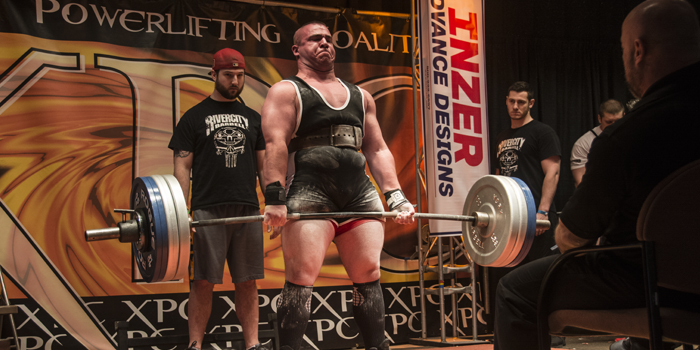
Since competing in the XPC Finals during the Arnold Sports Festival, I have had time to reflect on my experiences in this sport that have led me to this point. I have chosen to write this article not because I had a perfect meet, or because I’m a top-level competitor, but because I think those reading this article can relate to some of the things I have learned throughout my experiences leading up to my first time competing on one of the biggest stages in powerlifting.
On March 3rd, I competed in the XPC Finals at the Arnold on the elite day in the 275-pound class. As previously mentioned, this would be my first time competing on the “big stage.” I was obviously nervous, but I knew I was ready.
MORE: 2017 XPC Finals — JP Carroll Secures 1st Place
Squat
Warming up for squat, everything felt fast. I took my last warm-up of 635 pounds and was happy with it. The flights were moving very quickly so when they started mine I knew I had to be ready well ahead of time. I opened with 685 pounds and it felt unusually heavy, so my coach (Brandon Smitley) and I decided I should take a modest second attempt of 715 pounds. It also felt heavier than usual. I then realized that my rack height was a notch too high, so I was having trouble getting tight under the bar. I told them to lower it and as a result, 735 pounds felt better than my opener. No squat PR, but I was confident going into bench.
Bench
Bench has always been my weakest lift, so during this training cycle we implemented another bench day every week, which made a world of difference. I opened with 375 pounds and it felt like a warm-up. Next I went to 400 pounds, which would be a 20-pound PR. Nailed it. I decided to take 415 pounds as a third and it felt solid also. Possibly left a few pounds on the platform on bench, but I can’t complain with a 35-pound bench PR! Onto the deadlift.
Deadlift
There were about two or three of us that were neck-and-neck in my class, so it all came down to the deadlift. I pulled hook grip this entire meet prep, with my hook grip tape, which is fine in RPS. However, it was not permitted in the XPCs, so I went to mixed grip. This had me a little concerned because I hadn’t pulled mixed grip for months. My grip ended up not being an issue at all. I opened with 620 pounds, which moved great. Next, I went to 650 pounds, which would give me an 1800-pound total. I got it. At this point I was 25 pounds behind the leader, so I needed a 680-pound pull to secure the victory. It broke the ground, made it to my knees… and that’s about as far as it went.
That being said, it was primarily a technical issue. Brandon Smitley and Christian Anto helped identify what I did wrong and how I can fix it. I ended up taking second place. First would have been nice, of course, but I really can’t be upset with a 53-pound PR total.
There were some things I did well, and some things I didn’t do so well. Instead of acknowledging what I have accomplished, at this point, it’s time to primarily focus on what can be improved.
So with all things considered, I think the biggest takeaways from this meet would be:
- Don’t let your nerves get to you; it’s just another day in the office. Moving the weight was nothing new for me, so it needed to be treated as such, instead of letting it get into my head.
- STOP overthinking shit. I was my biggest enemy at this meet. Just have faith in yourself and your handler. Don’t worry about anything; you are there to be a mindless lifting machine on meet day. Stay hydrated and keep getting those carbs in your system. If you have a good handler, he or she will take care of the rest.
- Make sure you have everything figured out with equipment. Mentioned above, not having the proper rack height cost me pounds on squat. This was a rookie mistake that I will make damn sure to never let happen again.
- Really target your weaknesses during prep and focus on improving them. Brandon and I realized that my bench was significantly lacking, so we increased my bench frequency. This clearly helped me get stronger, but I think that the fact that I was benching twice as often and hammering the fundamentals helped the most.
- Make sure you know what is and is not allowed for that specific meet. Had my grip been an issue pulling mixed grip, I could have bombed. So always check well in advance.
- Pick smart attempts and know what you are and are not capable of. Obviously, you want to push yourself to the max, but don’t make a stupid jump (whether it be too small or too large) that could cost pounds on your total. I feel like Brandon and I chose just about the best attempts possible for what I had in me on that given day.
- You don’t know everything, so get as much useful advice from as many knowledgeable people as possible. This is one thing I did well. To paraphrase what Dave Tate once said, “If you think you you’re an advanced lifter, you aren’t. An advanced lifter is always continuing to try to learn more about what is out there.” This is not to say that I am an advanced lifter, but even the people who are advanced lifters realize that they can always learn from the person next to them.
- Read as many articles, books, etc., that you can get your hands on to expand your knowledge. That goes for anything, not just lifting. I have spent countless hours on elitefts.com reading article after article to try and improve myself.
Hopefully this will help keep you from making the same mistakes I did. Most of the mistakes we make as powerlifters can be avoided with proper information, instruction, and practice. We become better lifters if we learn from our mistakes, which is great and all, but if someone else has already made a mistake that you have the potential to also make, and they have learned from it, why wouldn’t they share that information with you to try to help you?
Nic is a sophomore at Purdue University studying Aeronautical Engineering Technology. From a small town in Northwest Ohio, powerlifting is rapidly becoming one of the most important things in his life.









